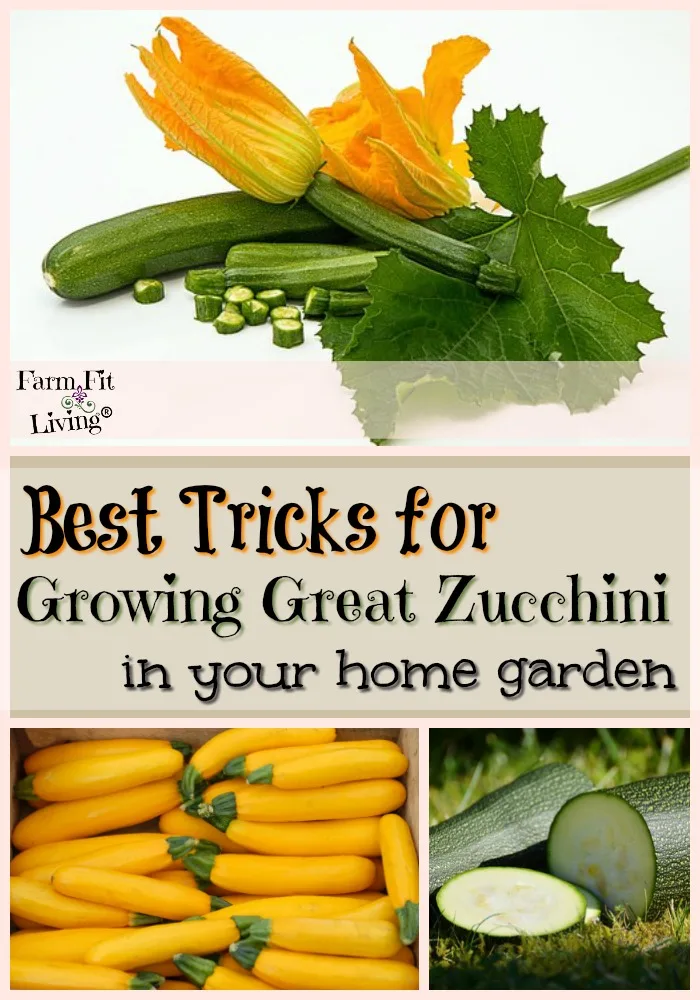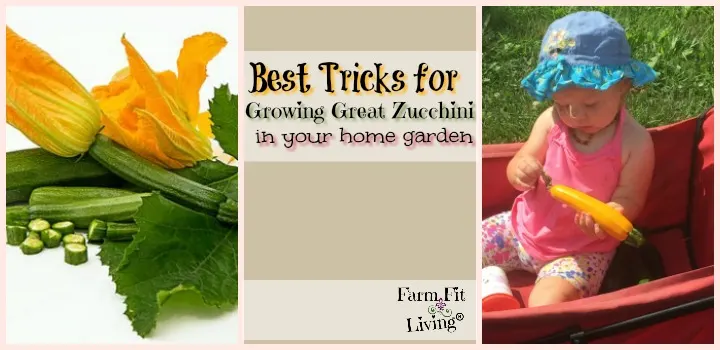Are you looking for the best tricks for growing great zucchini in your garden?
Zucchini is growing more and more popular in home gardens and on tables due to its versatility in meals. Zucchini is not only a veggie anymore.
It’s a pasta. A french fry. Dessert. Salad.
The possibilities are endless with zucchini. Mix it with anything and you’ll have a delicious and nutritious meal. So, how to grow more of it that you can preserve to enjoy all year around?
In this post, I will
- Uncover my best tricks for growing great zucchini
- Discuss a proper growing season for zucchini
- And cover some zucchini growing problems you might face
Every season, I keep the same zucchini plants producing for almost 2 months! And now, I’m sharing exactly what I did to do that with you. Keep on reading.
Which Types of Zucchini?
What’s the best zucchini to grow? Choose a zucchini variety that grows well in your area. In my area, a very temperate zone of 6a in Kansas, I have two types that grow very well. They include:
- Eldorado (Yellow Variety)
- Sunburst (Yellow Variety)
- Several types of green.
The best way to choose variety type is to just check your local garden stores. Or talk to someone from your local farmers market or garden club. They will definitely know which varieties to pick from.
Prepare for the Growing Season for Zucchini
The first thing that needs to be considered for soil is good soil. Zucchini will do well in any well-draining soil but they do require water regularly. So, make sure the zucchini bed is near by some water.
Another thing to consider is where zucchini was planted before. You want to rotate that spot if possible in order to prevent squash bugs from taking over your plants. So, simply plant your zucchini in a totally different spot, bed or container.
Also, zucchini plants love full sun but will take some shade as well. A little bit of shade during the day will keep the leaves and squash skin from burning during the heat of summer.
One more thing about the soil – The more nutritive the soil, the better the plants will perform for you. We generally apply our own livestock fertilizer in the fall after the growing season is over. Or before. However you want to look at it. We let that sit in the ground and let the moisture from winter soak it into the ground.
Then, in the spring, we work the soil where it will be nice and fluffy. Finally, make some hills and plant. I’ll talk about planting in the next section.
When to Plant
But first, don’t plant zucchini too early! Zucchini is a warm season crop that must be planted after all danger of frost has passed.
Here in Kansas, I like to plant zucchini in May. I direct seed into the hills and then water well.
Another really good time to plant zucchini is late July/early August for a good Fall crop. Note that this crop will need to be harvested before the first frost of Fall.
Zucchini Plant Spacing
Focus on learning how to grow zucchini from seed. Direct seed has been known to be much more effective than planting transplants.
Squash seeds are planted into small “hills” of topsoil. Simply take a hoe and maneuver fluffy soil to make a nice little hill wide enough to plant about 5 seeds per hill.
Plant squash seeds about two feet apart. Make hills at least 3 feet apart from each other. And keep in mind that these plants will expand. You might want to consider growing zucchini vertically if you need the space. But what’s more important than that is that the squash canopy (leaves) stay nice and green and healthy.
Let’s talk about the care of those plants.
Care Through the Season
Zucchini plants are pretty hardy and self-sufficient. However, there are a few care tips you can do to make sure your zucchini plants are producing for months. Yes. I said MONTHS!!
The first is making sure weeds stay clean. This is so the plants don’t have any competition at all in their hills. Weeds compete with squash plants, making shallow cultivation essential, especially early in the season. You can use black plastic mulch like this for warmer soil and weed control. Apply the plastic first, cut holes in the plastic and then plant the seeds.
If you don’t want to use black plastic as a mulch, use straw or organic matter instead.
Also, watering at the ground level is a great way to keep canopy healthy. Once the squash plants are growing strong, there’s not need for a lot of watering. They are pretty tolerant of drier soil conditions but you’ll want to make sure they have water at least once per week.
Finally, understand that squash plants need proper pollination. Like cucumber plants, squash plants have separate male and female flowers on the same plant. Therefore, honey bees and bumble bees are required to transfer pollen from flower to flower. Note that male flowers will appear first but the female flowers are the ones that produce the actual zucchini.
To get started with beekeeping, read here.
Harvest Time
Ok, now with good care and support, here’s where the magic happens. Yes, that magic of keeping plants producing for months. My zucchini plants produced for over two months last season using all of these tips I’m giving you today.
How cool is that? Here’s some harvest tips for ya as a bonus for best tricks for growing great zucchini.
First of all, zucchini is generally harvested at a tender stage before skin and seeds have toughened. Typical size is 6-10 inches long.
Also, keep in mind that regular harvest checks is important. Those zucchini babies develop super fast, so check every single day! They can be stored in a cool location for 1-2 weeks.
So, I think I’ve made growing zucchini sound super easy and flawless. Well, here are some problems you might face as you learn how to grow zucchini.
Potential Zucchini Growing Problems
Zucchini has the reputation of producing. And producing. And producing.
There’s actually jokes that you can’t give zucchini away near seasons end. That’s when you know the season is over. But, there are several potential problems that could be a cause for why your zucchini plants may not be producing.
Zucchini flowers but no fruit
You might be seeing lots of flowers but no little zucchinis yet. Well, that’s because you might just be seeing the male buds. Remember that there are male and female flowers that need to be pollinated in order to make zucchini babies.
The males produce the pollen for female flowers that have the tiny squash behind them. Typically, the male flowers appear first and contain the pollen. So the solution to this is to wait. Bees come in and spread the pollen to the female flowers and after that, you’ll see some zucchini.
Zucchini fruit set but rot
Do your little zucchinis look like they have some rot on them? Gross.
But, in reality, it’s because of rainy weather and damp conditions. If zucchinis are sitting on the ground in the water and mud for a lengthy period of time, they are going to start to decay.
To prevent this, use mulch as I mentioned above. You can also try to keep the zucchinis off the ground by the use of a cage or trellis.
Squash Bugs
Oh, these little bugs that are fun to squash. These bugs are grayish black and orange. They attack squash plants by the hundreds, sucking the sap and nourishment from the plants, which results in the collapse of the vines.
There are a couple of ways to control them:
- Rotate squash bed locations. They tend to follow eventually, but you might be able to beat them.
- Monitor the plant for the presence of them and use a spray, such as Sevin, around the base of the plant and up under the leaves. Spray in the evening when the flowers close up.
Remember that control is essential for proper health of the plants. If there aren’t too many bugs, I will usually just pull them off and squish them dead in between my fingers or step on them. Just make sure they are dead.
Squash vine borer
Here’s another insect problem you might see. This one is worst than squash bugs and more difficult to control.
It lays its eggs on the main stem of the plant where it emerges from the ground. Then, the eggs hatch and the larvae bores into the stem. The insect develops into a large, dirty white grub-like larvae.
So, what does it do? Well, it destroys the vascular system of the plant. Once the plant collapses, there is no control. So, what to do?
Start preventative insecticide soon after the plant has emerged. You can use certain organic methods or conventional, like Sevin. Apply in the evenings when the blooms are closed every couple of weeks for the best control targeted in the plant’s main stem.
There are always options, but one thing is clear. If you have problems, you must provide proactive control. If you don’t, you won’t have zucchini at all.
And how sad would that be?
What To Do With All That Zucchini??
By following these best tricks for growing great zucchini, you’ll more than likely have a ton of it to do something with. I love eating zucchini in all different ways.
Some of my favorite ways include:
So, that’s it! I truly hope you have a great zucchini growing season and produce plenty of zucchini to your liking.
If you liked this post about the best tricks to growing great zucchini, check these out:


Make Gardening Simple Now!

Simple gardening equals smart gardening. In this short, easy to read book, you'll get access to all the best practices and tips for gardening smarter and more successfully. If you want more information, I'll send it right to your email inbox!



